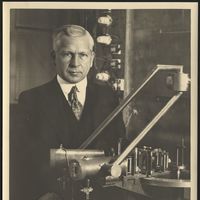
Our History
The Early Years, 1891 through the 1930s
Stanford University opened in 1891, with the Department of Physics among the very first departments at the new University. As the Register for 1891-92 indicates, five courses in physics -- both laboratory and classroom -- were offered to the inaugural class of enthusiastic young men and women. Research was not far behind, however. By the early 1900s, research on X-rays had begun, first under the direction of David Webster, and later under Paul Kirkpatrick. It was not until the arrival of Swiss physicist Felix Bloch, however, in 1934, that physics research at Stanford truly caught fire. A refugee from the Nazis, Bloch was only 28 years old when he answered David Webster's invitation to join the Stanford faculty. Yet he had already made extraordinary contributions to physics, through his theory of electron transport, the Bethe-Bloch equation of the stopping power of fast particles in matter, the theory of ferromagnetism, his invention of spin waves, and Bloch walls. Soon after he arrived at Stanford, Bloch, together with Berkeley physicist Robert Oppenheimer, organized a joint seminar on theoretical physics that met alternately at Stanford and Berkeley. Many of the leading physicists of Europe and the United States traveled to the West Coast to speak at these seminars, and many came to Stanford as summer visitors. By the mid-1930s, Stanford was recognized as an important center for physics, despite the fact that geographically it was considered far removed from the center of "civilization!"

The Middle 1930s through the 1960s
Encouraged initially by Enrico Fermi to do experimental physics because, among other things, it was "fun," in 1938 Bloch (in collaboration with Luis Alvarez) made the first experimental measurement of the magnetic moment of the neutron, marking the beginning of the work for which he is perhaps best known. By the end of the Second World War, Bloch, working with Bill Hansen and Martin Packard, had succeeded in observing nuclear magnetic resonance (NMR) in condensed matter by the method of nuclear induction. For these discoveries, and the discoveries made with this technique, Bloch shared the 1952 Nobel Prize in Physics with Harvard's Edward Purcell. It was Stanford's first Nobel Prize. NMR has since become the most important spectroscopic technique in chemistry and biology, and magnetic resonance imaging (MRI), an imaging technique based upon it, is considered the greatest advance in medical imaging since the discovery of X-rays in 1895.
In the late 1930s, Research Associates Russell and Sigurd Varian, working in collaboration with their mentor, Professor Bill Hansen, invented the klystron, a high-power microwave source and amplifier. The klystron was rapidly developed during World War II for use in radar, navigation, and blind-landing devices for aircraft. But Hansen, whose own contribution to the klystron was the resonant cavity called a rhumbatron, was interested in using the klystron for the acceleration of particles. And by 1947 he had built the first linear electron accelerator, the Mark I, which accelerated electrons to 6 MeV. Then, just four years later, Edward Ginzton and Marvin Chodorow completed the Mark III, a 1-GeV electron accelerator. It was the Mark III that allowed Robert Hofstadter to study the charge and magnetic structure of nuclei and nucleons, work that earned him the 1961 Nobel Prize in Physics.



Stanford Linear Accelerator Center
Hansen's work has continued to be highly fruitful. In 1967, the Stanford Linear Accelerator Center (SLAC), a national facility designed to hold a new two-mile accelerator, was completed and running, and nine years later, Stanford's Burton Richter shared the Nobel Prize for the discovery of the Psi/J-particle. In 1988, Mel Schwartz, a long-time member of the department, shared the Nobel Prize for his discovery of the muon neutrino, though this work had been done earlier at Brookhaven. Then, in 1990, Dick Taylor shared the Nobel Prize for his studies of deep inelastic scattering, which showed the existence of point-like objects in nucleons, now recognized as quarks. In 1995, Martin Perl won the Nobel Prize in Physics for his discovery of a new elementary particle known as the tau lepton.



















